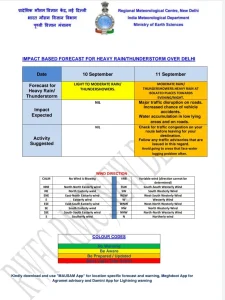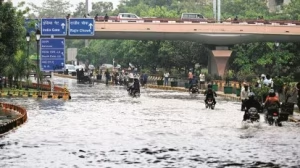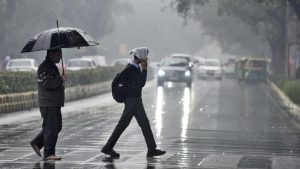New Delhi – Delhi rain today created unprecedented chaos across the national capital and parts of the National Capital Region (NCR) as heavy downpours early Sunday morning triggered severe waterlogging in multiple areas. The intensity of Delhi rain today disrupted normal life, affecting transportation, flight operations, and daily commuting patterns throughout the region.
The impact of rain today extended beyond mere inconvenience, with thunderstorms and strong winds reaching speeds up to 60 kilometers per hour lashing the capital. Temperature readings during Delhi rain today showed mercury levels at 21.2 degrees Celsius, providing some relief from the usual heat but creating challenging conditions for residents and commuters.
IMD Issues Red Alert Ahead of Severe Weather

The India Meteorological Department had proactively issued a red alert for Delhi and nearby regions on Saturday, anticipating the severe weather conditions that materialized with heavy rain today. The warning specifically cautioned residents about heavy thunderstorms, strong winds, and lightning activity that would accompany the rainfall.
According to the IMD’s “Nowcast” advisory released prior to Delhi rain today, “A thunderstorm cell is approaching Delhi and adjoining areas from the west/northwest.” This advance warning proved accurate as heavy rain today unfolded exactly as predicted, validating the meteorological department’s forecasting capabilities.
Extensive Waterlogging Paralyzes City Infrastructure
The most visible impact of heavy rain today manifested through extensive waterlogging across various parts of the capital. Visuals from different locations revealed the overwhelming extent of disruption caused by the heavy precipitation, with water levels rising dramatically in numerous areas.

Heavy rain today created particularly alarming conditions where water levels rose high enough to completely submerge smaller vehicles in several locations. The accumulation of rainwater demonstrated the inadequacy of existing drainage systems to handle the volume of precipitation that Delhi rain today brought to the region.
One of the most concerning scenes during Heavy rain today occurred at Minto Road, where a car was spotted almost fully underwater. This incident highlighted the severe drainage deficiencies in the area and drew attention to infrastructure limitations exposed by Delhi rain today.
Airport Operations Severely Disrupted
Flight operations at Delhi’s Indira Gandhi International Airport faced significant disruptions due to Delhi rain today, with heavy rainfall and strong winds creating hazardous conditions for aircraft operations. The impact of Delhi rain today on aviation included delays, cancellations, and temporary operational suspensions.


According to flight tracking data, Delhi rain today caused average delays exceeding 30 minutes for outgoing flights. Several departures were postponed, and multiple flights faced cancellations as airport authorities prioritized passenger safety over schedule adherence during the severe weather conditions.
The challenges posed by Delhi rain today included low visibility and wet runways, which contributed to temporary airside congestion at the country’s busiest airport. IndiGo Airlines acknowledged the impact of Delhi rain today by posting updates about adverse weather conditions leading to temporary flight operation disruptions.
Traffic and Transportation Chaos
Delhi rain today created significant transportation challenges across the capital, with waterlogged roads severely impacting morning traffic patterns. The accumulation of rainwater on key stretches disrupted normal vehicle flow, causing extended delays for commuters throughout the affected areas.
The traffic situation in Dhaula Kuan exemplified the broader impact of Delhi rain today, where vehicles crawled slowly through heavily waterlogged streets following overnight rainfall. Commuters faced substantial delays as standing water created hazardous driving conditions and reduced road capacity.
Near Terminal 1 of Delhi Airport, the effects of Delhi rain today transformed roads into water channels, making commuting extremely difficult for passengers and airport staff. The Moti Bagh area reported similar conditions, demonstrating the widespread nature of waterlogging caused by Delhi rain today.
Regional Impact Beyond Delhi Boundaries
The weather system responsible for Delhi rain today extended its impact beyond the capital’s boundaries, affecting parts of Haryana including Jhajjar and Karnal. These areas experienced similar thunderstorms and strong winds, indicating the regional scale of the weather phenomenon.
The broader meteorological pattern associated with Delhi rain today reflected larger seasonal shifts occurring across northern India. The intensity and timing of these weather events suggest changing precipitation patterns that may require enhanced preparedness measures for future occurrences.
Airport Recovery and Operational Resumption
Despite the initial disruptions caused by Delhi rain today, airport operations gradually stabilized as weather conditions improved throughout the morning. IndiGo Airlines provided regular updates, initially reporting disruptions at 3:59 AM and later confirming operational resumption at 5:54 AM as clearer skies emerged.
The recovery process following Delhi rain today demonstrated the resilience of airport infrastructure and the effectiveness of contingency planning. Air traffic management teams worked efficiently to restore normal operations once the immediate weather threats subsided.
IGIA’s experience during Delhi rain today highlighted both vulnerabilities and strengths in handling severe weather events. The temporary nature of disruptions, while inconvenient, showed that established protocols effectively managed safety priorities during challenging conditions.
Monsoon Arrival and Seasonal Context


While Delhi rain today created localized challenges, the broader weather pattern signaled significant seasonal developments. The IMD confirmed the southwest monsoon’s arrival in Kerala on Saturday, marking its earliest onset since 2009, providing context for the intensity of Delhi rain today.
The monsoon system has already reached parts of Maharashtra, Karnataka, Tamil Nadu, the Lakshadweep area, the Bay of Bengal, and northeastern regions. This early monsoon activity may explain the intensity and timing of Delhi rain today within the larger meteorological framework.
Historical Weather Patterns and Infrastructure Challenges


Delhi rain today follows similar weather events from the previous week that also caused significant disruptions across the capital. Earlier instances led to power outages in various areas including Bawana, Narela, Jahangirpuri, Civil Lines, Shakti Nagar, Model Town, Wazirabad, Dhirpur, and Burari.
The recurring nature of disruptions during severe weather events like Delhi rain today highlights ongoing infrastructure challenges that require systematic attention. Drainage systems, power distribution networks, and transportation infrastructure continue to face stress during intense precipitation events.
Emergency Response and Public Safety Measures
The impact of Delhi rain today necessitated coordinated emergency response efforts across multiple agencies. Traffic management, airport operations, and municipal services worked together to minimize disruptions and ensure public safety during the severe weather event.
Public advisories issued in connection with Delhi rain today emphasized the importance of avoiding waterlogged areas and planning alternative routes for essential travel. These precautionary measures proved crucial in preventing accidents and ensuring citizen safety during the challenging conditions.
Future Preparedness and Infrastructure Development
The experience of heavy rain today underscores the urgent need for comprehensive infrastructure upgrades to handle extreme weather events. Improved drainage systems, enhanced airport resilience, and better traffic management protocols represent essential investments for future preparedness.
Heavy rain today serves as a reminder that climate variability requires adaptive infrastructure and emergency response capabilities that can effectively manage disruptions while maintaining essential services for the capital’s residents and visitors.

